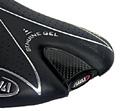
Recently on Cyclingnews.com |
On test: Selle Italia Signo Genuine Gel Road Saddle, May 3, 2005
Rock 'n' Roll
Steve Beletich examines yet another techno-packed marvel from Selle Italia, the heart of which is a pivot system which allows the saddle to rock from side to side with each pedal stroke.

|
The Signo Genuine Gel is one of the more recent additions to Selle Italia's already vast line-up of more than 50 hand-made Italian saddles. Its base consists of a Rylsan shell with three gel inserts, wrapped with the now ubiquitous Lorica fabric. This sits atop polymer shock absorbers and tubular Vanox steel rails.
The Signo's rails are conventionally anchored at the saddle's nose, although at the rear they meet the saddle base at its centre, rather than under the side 'wings' as is typical. This central union of rails and saddle base is pinned longitudinally, to allow restricted oscillation of the saddle in harmony with your pedalling motion. Therein lies the heart of the so-called 'articulated oscillating saddle base'.
My first impression of the Signo was of course the unusual centralisation of the rearward saddle rails. Blind Freddy could see that the intention of this is to allow the saddle to pivot on an axis parallel to the bike's top tube. Even before installing the saddle, I was readily able to deform the base around this axis whilst holding the rails in my bare hands.

|
Other standout features were the red rubber shock absorbers immediately under the shell and the attractive triangular carbon insert at the rear of the saddle surface. I was also left with no doubt that the Signo took some styling cues from the Flite Genuine Gel, which remains an all-time favourite of roadies everywhere, myself included.
I had to spend marginally longer than usual installing the Signo, as the rails were 3-4mm wider than the channels in my seat post clamp. I'm not sure if this is intentional, e.g. to pre-load the rails in some way, but it did take a little effort to squeeze them inward whilst tightening the clamp. No major drama however.
Once installed, the first 'sit' felt firmer than the Selle Italia SLK I had just removed from the Merckx test bed (although I was wearing denim jeans at the time), which is possibly due to its less generous padding. However the Signo's firm sensation in 'static' mode was going to be very different to the way it felt during riding, as I was to learn later.
Whilst coasting, the saddle's suspension system and tubular rails effectively soaked up all small to medium sized bumps. Close encounters with man-sized potholes seemed to cause the saddle base to deform significantly in the centre, banana-style. This occurred to the point where I felt the saddle would 'bottom out' over very large holes - the base seemed to actually make contact with the seat post clamp beneath it. The saddle would then spring back from this deformed position and throw my weight upwards, which caused me to bounce and slide around a little. Mind you, we are talking about some pretty serious potholes here, not your average tiptoe through the tulips.

|
I have to say that it also felt like too much of my weight sat centrally, in that delicate area, and that not enough of me was sitting on my ischial bones. No doubt this a function of the centrally-supported saddle base and resultant flexibility of the rear wings.
Under pedaling, the Signo did pivot from side to side, as per its design intention. I can't say that I warmed immediately to this sensation, although I did find that with it came a noticeable reduction in pedaling effort. The saddle wings would yield ever-so-slightly under my thighs on each downstroke, and ipso facto it felt like I saved a couple of watts of pedaling power.
In conclusion, it has to be said that individual preferences and subjectivity will always dominate a rider's likes or dislikes for a particular saddle - let's face it, there's a hell of a lot of nerve fibres located in your rear end. Personally, I'm not the lightest rider around and I like to feel that my ischial bones are firmly supported by the saddle wings. Add to this the fact that I'm riding some of the crappiest roads that Sydney has to offer, and I have to conclude that the Signo's 'articulated oscillating saddle base' was not ideal for my tastes. I tended to oscillate a little more than I wanted, and bounce around on very rough roads. You might say I would prefer a little more rock (firmness) and a little less roll (pivot).

|
Having said that, I can imagine that a lighter rider, on better roads with less of a preference for saddle firmness, would love the feel of the Signo and embrace the obvious pedaling advantage it offers. For example, I reckon a time trialist or triathlete (sans chamois) could get a lot out of the suppleness and efficiency of this saddle - several less watts of thigh rub could translate into a winning margin over the course of a race.
Suggested retail price: €109 / US$145
Claimed weight: 225 g +/- 8%
Measured weight: 255g
Dimensions: 141 x 277 mm
Colours: Black
Materials: Lorica, tubular Vanox
Pros: Noticeable reduction in pedalling effort
Cons: Lack of ischial support
More information: www.selleitalia.com
Cyclingnews Rating: ![]()

